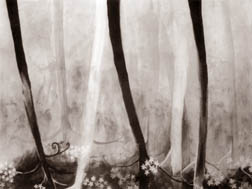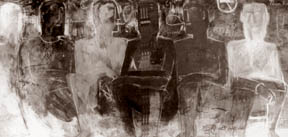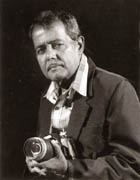|
dailynews |
|
|
|
|
|
OTHER LINKS |

|

|

|
|
|
|
|
PAINTING: After his first solo exhibition last year Chamila Gamage, who hails from Beliatta in the south, presents his second collection of work which are strange dabblings of an artist.
A graduate (sculpture) from the University of Visual and Performing Arts, Gamage has trained at the Institute of Printing and Graphics and also at the Vibhavi Academy of Fine Arts, a combination which seems to have resulted in this exciting outcome of a hybrid nature.
Walking through his collection one would quickly notice the big contrast in colour combining of Gamage and many of his other contemporaries.
It also stand as a unique feature of his work which art lovers will find interesting.
A palette consisting mostly of amber, bronze, a mix of earth colours with, sometimes hues of other standard pigments such as reds, blues or greens. The celebration begins not with the appearance of these colours on the canvases as much as the way that the artist have carefully composed them.
|
|
|
|
The appearance of light within his work, which the artist has managed through the manipulation of brush and white, is another interesting factor which has, in most cases; given the artist the opportunity to bring a sense of depth to his work.
What also attracts one's attention is Gamage's nonchalant approach towards using colour and brush, which has evidently produced vivid textures, forms and shapes on the surface of his canvas beside the actual images the artist has been grappling with from the beginning.
Beside his wide collection of figurative expressions using the human form, Gamage has suddenly deviated at one point to use the form of trees in one of his paintings, aptly titled 'Forest'.
This painting stands out from his present collection mainly because of the sudden change of subject matter by the artist, almost midway (in the order it was hung) but not changing much from the other features that has by then become the hallmark concerning his work.
Artist Chamila Gamage,has exhibited regularly at group exhibitions since 2001 until last year's solo exhibition by him. He was the recipient of a merit award at the State Art Festival in 2002 and also received the first prize when he participated in the poster competition held to mark World Aids Day in 2000.
With this new collection, now showing at the Paradise Road Galleries, the artist has left enough room for the viewer to imagine beyond the images that he sees and for the artist himself, to deviate into other areas, if he wishes in the future. The exhibition ends on August 23.
The antiquity of Kandyan dancing and growth
|
|
DANCE: The earliest epigraphical record of processions is the Rock Edict of Emperor Asoka of the third century, where he says that in the past rulers went on pleasure trips which involved hunting.
King Devanampriya Priyadassi, in order to stabilize the Dharma caused public shows or processions wherein elephants paraded the streets and vehicles with 'vimanas' (pavilions) torches of fire too became components of these public shows.
It could be deduced that Arahant Mahinda, son of Emperor Asoka, who introduced Buddhism to Sri Lanka during the time of King Tissa later on his second coronation under Mauyrya traditions was invested with the Mauyryan title Devanampriya (beloved of the Gods) too after spending the first vas (Rains' Retreat) at Missakapabbata at Anuradhapura would have arranged the civara-puja (robes offering) to the 62 monks who observed vas, by the robes being taken from the king's palace to Missakapabbata in the dawn, as is now done, with a procession of elephants, music, dancers and fire-torches, as was arranged by his father.
The eighteen guild members Arahant Mahinda brought from Vedisa (Ujjaini/Ujjain, in Madhya Pradesh) among others were musicians, weavers, dyers and ivory-carvers (Dantakarins), and other artisans as well as his maternal relations, the rich bankers, and entrepreneurs to finance the construction of Viharas (Vaisya-sresthins/setthis) who on having completed their task, 500 of them, entered the order and resided at their own abode, Vessagiri/Vaisyagraha (abode of vaisyas) as testified by the 26 cave inscriptions in situ at Anuradhapura.
As regards the annual Sri Dalada Perahera, the 5th century A.D. visiting Chinese pilgrim monk, Fa-Hien in his travelogue says, "the Sacred Tooth Relic was deposited in a grand mansion beside the king's palace and was taken in a procession to Abhayagiri Vihara in a grand procession, with the roads gaily decorated with paintings of Jataka stories and kept there for three months for pubic veneration and brought back to the Vihara in a similar fashion to the mansion of the Sacred Tooth Relic."
Naiyandi
This is a very showy dance, with strides and steps employing both the 'close' and the 'extended' movements. In South Indian folk art, Naiyandi Melam is the name for the distinctive orchestra, consisting of two players on Nagaswara, two on the 'tavil' (drum), one playing the 'pambai' (pair of drums) and one drumming Kirikatti. Thus Naiyandi form is a South Indian migrant form of dance.
The dancer is in an appropriate attire of white, chest covered with a network of beads, rows of beads round the neck, waist band, strings of silver chains, ear pendants, brass shoulder pads, jingles and anklets and a head dressed with a white turban.
The Kandyan dance tradition has five aspects, the Ves, the Naiyandi, the Pantheru, the Udekki and the Vannam.
Udekki
The Udekki dance is named after the accompanying musical instrument of the same name, in the shape of an hour glass. This is held by the narrow waist of it and played with the hand producing the weird metallic mystic vibrations. This too is an instrument popular in the ritual dances of South India, which in India is in a diminutive form called Damaruka, which is supposed to be held in the hand of God Siva in the Nataraja dance.
Pantheru
The Pantheru dance too derives its name after the accompanying musical instrument. This is a metallic hoop, similar to gypsy tambourine minus its parchment covering it. This is danced to the rhythm of the Geta Bera by a group of dancers in serried ranks holding the pantheruwa, turning and twirling it, alternately changing from hand to hand.
The dancer is costumed in a white pleated garment, running round the waist, the chest ornamented with a network of bright beads, strings of beads round the neck, waist band, brass shoulder pads, ear pendants, armlets and bracelets, jingles and anklets. The entire outlook of this attire is suggestive of the South Indian military band of old marching to the battle field with the light infantry.
Ves
The most graceful of the Kandyan dances is the Ves. The ritual and exorcist role of this dance is evidenced in the rituals of the Kandyan Kohomba Kankariya, the elaborate cult of the Kohomba Gods. The Ves dancers performance are reminiscent as of a replica of the Malayaraja of Malaya-rata, the royal magician who arrived in the island from South India to cure King Panduvasdeva, the successor of King Vijaya (6th century B.C.) to cure and incurable malady which had affected King Panduvasdeva.
The costume of the Ves dancer is called, the Su Seta Abharana, the sixty-four ornaments. The dancer called the Yakdessa, today has only a few of the 64 ornaments. These dancers make-up is totally in consonance with that of the Kathakali dancer of Kerala (South India).
This close affinity could be discerned in the character of Tandava type of dance, which is essentially of Kathakali Tandava, masculine vigorous type.
The Tandava is a masculine dance accentuated with strength, majesty, speed and expansiveness. The Kandyan dancers' pose and stance are totally those of Kathakali. Although Kathakali is purely pantomimic dance-drama with an elaborate hasta and abhinaya, the Kandyan dance is purely narta with a highly developed system of tala.
Vannam
In the Kandyan dance, the Vannam are of constituent solo dances, each expressing a dominant idea pertaining to each dance. The classical Vannam are eighteen. The first parading the streets in the Esala Dalada Perahera is Gajaga Vannam, the majestic gait of the elephant of sacred legends, Iravana sporting in the cool waters of the lotus tanks, bathing, frolicking and striding in mirth.
The next is Naiyandi, an embodiment of Bhuridatta Jataka - born a princely Naga in the Naga world. This deals with the ascetic meditation of the Bodhisatva in the guise of sanakr on an ant hill beside the river Yamuna of India.
This is followed by Kirala Vannama (notes of the bird kirala on search of food), Udara Vannam the king in his 64 ornaments riding the streets in an elephant, Sinha Raja Vannam, a cunning tortoise luring a lion into a deep well, where it perishes, Hanuma Vannama imitates the action of the monkey, in the Indian epic of Ramayana of Valmiki of Varanasi (Benares). Then comes Ganesa Vannam in praise of God Ganesa.
This is an invocation to him by Rishis of India. Kukkuda Vannama is the long drawn battle between Devas and Asuras. The Vairodi Vannama is of the palace of God Isvara depicting the moral that the boastful are wicked and detestable.
The Mayura Vannama sings the praise of the nobel peacock, the vahana (vehicle) of God Kadira, the War God resident in Kataragama (Kajaragama) of the Sakyans of old refugees from North India escaping the wrath of Prince Vidhudhaba, the illegitimate son of a slave girl of King Pasenadi, who massacred the Sakyans of Kapilavastu (Nepal Terai, Tilaurakot).
Turanga Vannama is the Prince Siddartha on horse back (Kanthaka) and leaving with the horseman (Channa) having renounced household life in the quest of enlightenment, Isvara Vannama, is the flight of God Isvara in search of his spouse Uma. Musaladi Vannama is the movements of a rabbit. Naga Vannama is the life of a cobra crawling at random in the palace. The most delightful is the Asadissa Vannama singing praises of the Buddha.
These eighteen Vannamas are of the Kandyan adaptations of Indian mythology. Thus there is an unbroken affinity in Kandyan dancing with Bharata Natya of South India, Kathakali of Kerala and the Hindu pantheon of South India of Saivasim and of the North Indian Vishvanite in the Vishnu Devale Perahera. The Pattini too is of South Indian origin, the only Goddess of the Sri Lanka pantheon, the consort of God Vishnu.
(The writer is a member of the Bharatiya Kala Kendra of India and a noted critic of Indian arts and crafts and cultural heritage).
Composed: the Music of Eshantha J. Peiris
|
|
MUSIC: More readily recognized on the local music scene for his appearances as a classical pianist and rock keyboardist, Eshantha Peiris will return to the stage to present a recital of his original musical compositions at the Russian Cultural Centre Hall on August 18 and 19 at 7.15 pm.
Eshantha, who is currently pursuing a Master of Arts degree in Music Composition at New York University (where he also teaches in the piano department), began his training in piano and music theory with Ramya Perera, and later furthered his passion for the creative side of music under the guidance of composers Marc-antonio Consoli (classical), Ira Newborn (film) and Jim McNeely (jazz), while picking up a Diploma and a Bachelors' degree in piano performance along the way.
The recital programme consists mainly of chamber-sized classical and jazz compositions by Eshantha within the last four years, with some of the works having been composed/arranged especially for the weekend's performers.
The talented performer line-up comprises several of Sri Lanka's emerging generation of musicians, including vocalists Anjuli Gunaratne and Eranga Goonetilleke, string instrumentalists Namali Fernando (cello), Amal Abeysekera (viola) and Satish Casie Chetty (violin), flautists Sureka Amerasinghe, Tilanka Jayamanne, Ruvindra Angunawela, Natasha Senanayake, and Johann Peiris (alto flute), drummer Sumudi Suraweera, bass guitarist Alston Joachim, and the composer himself at the piano.
Also featured will be a composition each from Sri Lankan composer Natasha Senanayake and Brazilian composer Edmundo Villani-Cortes.
Programmed with a music-loving Sri Lankan audience in mind (and including a hint of interactive audience participation), 'Composed: the Music of Eshantha J. Peiris' promises to be an enjoyable/thought-provoking evening's worth of musical offerings.
Entrance-Programmes will be available at the Russian Cultural Centre (open 9 am - 7 .pm daily).
Chandrasena's 'Captured Moments'
|
|
PHOTOGRAPHY: Veteran art photographer Chandrasena Perera is exhibiting his photographic creations - "Captured Moments... an ode to light and shade" at the YMBA hall Kurunegala from August 18 to 20 on the invitation of the Kurunegala Photographic Society.
Chandrasena, a qualified artist of repute being in the field for over 30 years, holder of a considerable number of awards from National and International salons of photography besides the hundreds of acceptance certificates, is scheduled to display over 50 creative photographic essays which incidentally has had his compositional excellence in photography acclaimed and reviewed positively at the exhibition held in Colombo last year.
The following excerpt from his exhibition catalogue is an excellent introduction to his work and states - "Mundane subjects meet our eyes every day but unfortunately do not apparently see the splendour that is there for free.
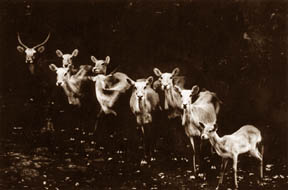 |
A woman walking pensively trailed dutifully by a child on a lonely stretch of roadway, a bare bodied village blacksmith toiling silently at his anvil, a sign board painter with the paraphernalia of his trade lying at his feet perched precariously high on scaffolding or even such boring subjects as a perspiring labourer pouring scalding tar from a pail to re-surface a road; to such exotic images as young maidens in charming attire being ferried by an elderly boatman through a veil of mist early one morning; images that has human interest; images - the traditions the customs that are captured for posterity in a world where values are fast diminishing".
This exhibition is being presented as the second such away from the city hub and for the photo artists and students to observe and study, is to be opened by world renowned photographer Dr. T.S.U. de Zylva.
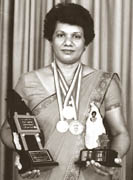 Primary teacher receives honours
Primary teacher receives honours
Manel Rajapaksa of WP/K Aluthgama Sangamitta Balika Maha Vidyalaya has been awarded the Presidential Golden Award of 'Vidya Pradeepa'.
She received this honour as the Best Primary Teacher in the Kalutara Zone in the Teachers' and Principals' Presidential Awards 2005-2006 ceremony conducted by the Western Provincial Ministry of Education.
She was awarded the honour of 'Vidya Prabhu' in the Teachers' and Principals' awards ceremony conducted in the year 2003, and in the year 2002, she became the first primary teacher in the Kalutara Zone who was offered a foreign scholarship for primary teachers for the first time in 2002.

